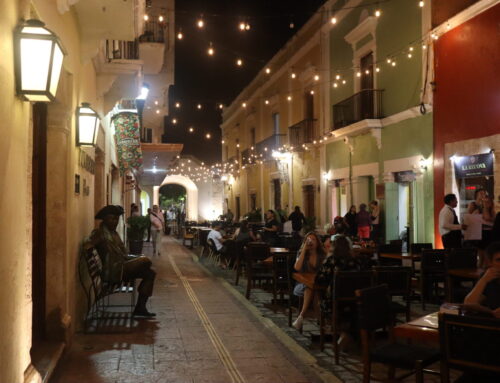The boat sped down the Ria Lagartos estuary, passing shallow islets of tightly packed mangrove trees. Its waters were different shades of turquoise, mixed with the emerald green of the leaves and the bright baby blue of a clear July sky. The Yucatec sun beat down on us, and I was sure my head was getting cooking inside the hat I’d very wisely donned to keep the brutal rays at bay.
We were taking a tour of the inlets beyond Rio Lagartos, a protected estuary in northern Yucatán. We were on our way back to port. For the past couple of hours, we’d been admiring the dense forests of mangroves and tropical vegetation. We’d seen flamingos eating plankton in the shallow, sandy waters, as well as all manner of hawks, eagles, ducks and other birds that called the estuary their home.
The pilot then slowed the motor down and beached the skiff in a small nook in between the mangroves. We descended from the boat like Spanish explorers, eager to uncover the mysteries that these swampy, little islands held. According to accounts, Cortes had actually landed here at the onset of his expedition into Mexico, looking to take water before heading north into the waters of the Gulf of Mexico. The Spaniards had aptly named the place Ría Lagartos, Alligator Lagoon, after the massive numbers of the critters that make their home amongst the maze of roots— which is why we hadn’t done any swimming.
Our guide beckoned us to a little clearing, where the ground beneath us was made up of spongy clay, causing our feet to sink in the humid mud. He took a plastic bottle filled with seawater and dug a hole on the ground with a dry mangrove branch, prying the white, clay loose, as if we were going to plant daisy or tomato seeds. When he’d gathered enough loose clay, he then poured the water and mixed it up with his hands until it became mud.
“Cover yourself with it,” he said, extending a handful of mud to me.
“Huh?”
“Cover yourself with the mud! It’s good for your skin!”
Okay. I took several handfuls of clay, moist and squishy to the touch, and placed it over my skin. A slight breeze was blowing, and I immediately felt cooled, refreshed by the combination of mud and wind.
The white clay that comes from this swampy estuary is a natural exfoliant that supposedly contains high amounts of sulfur, seaweed, salts, nutrients and other minerals that hydrate and exfoliate the skin. When I rubbed it into my reddened shoulders, I felt it did help somewhat with my peeling from my sunburn (the sun always gets me on the first day). This activity has become popular in recent years, especially among European and American tourists that visit the area. Who wouldn’t want to get a Maya beauty treatment with your tour through the estuary looking for alligators?
The ancient Maya that used the waterways as commercial routes used to cover themselves in the creamy mud as protection from the elements, namely from the sun and mosquitoes— and small wonder, it feels great! Whether they also used the mud recreationally as an exfoliant is something that remains a mystery.
In no time, our little group had covered up in the stuff, and we ended up looking like fierce warriors. We joked about and took pictures as we played with the mud or drew shapes with the clay on our bodies.
Thus clad in the mud, we got back on the boat and sped to a nearby beach, where we’d wash the mud off. On our way there, we passed another boat crammed with tourists speeding up the waterway. They stared at the white creatures we’d become. I stood up and beat my chest like Tarzan, causing them to laugh and wave. What savages we must have looked like!
Taking a Maya mud bath is one of those unique experiences that are restricted to certain places. If you want to live it, you must travel to Rio Lagartos and take a tour of the estuary from the waterfront. Hiring a boat for the tour costs about several hundred dollars (depending on the boatman). Tours usually include sightseeing and birdwatching, some refreshments (or bring your own), as well as the opportunity to get the Mayan bath.
We arrived at the beach that lay before the fishing village, our final stop before heading back. As we washed the dry clay from our skins, we joked and swam in the shallow warm waters. I felt exhilarated, my spirit refreshed from the new experiences of exploring the swamps and trying new things.
One thing is clear: you can never be too old to play in the mud.



Leave A Comment